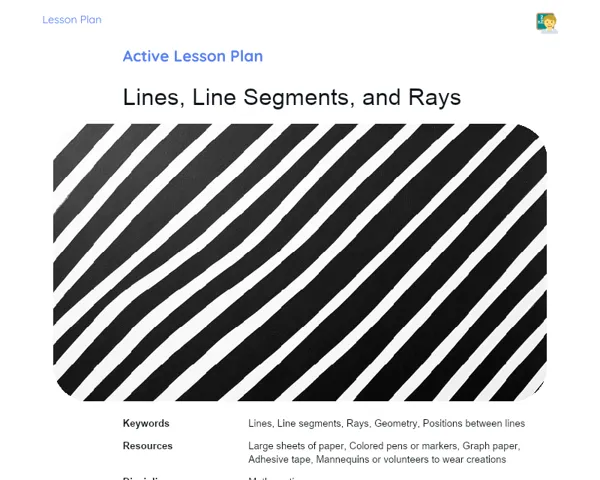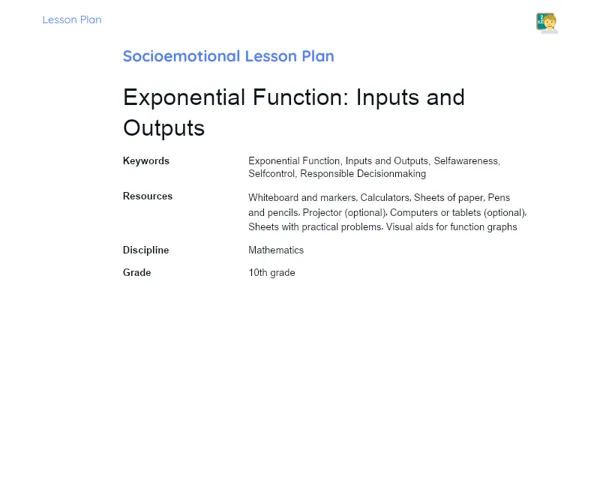Lesson Plan | Lesson Plan Iteratif Teachy | Irrational Numbers
| Keywords | Irrational Numbers, Mathematics, 9th Grade, Digital Methodology, Active Learning, Social Media, Collaboration, Critical Thinking, Mathematical Operations, Problem-Solving, Contextualization, Practical Activities |
| Resources | Cell phones with internet access, Video and image editing apps (like InShot, TikTok, Instagram), Projector or screen sharing, Computers with internet access, Digital escape room platform, Audio, video, and text files for 'investigation kits' |
| Codes | - |
| Grade | 9th grade |
| Discipline | Mathematics |
Goal
Duration: 10 - 15 minutes
This stage aims to prepare students for understanding the key objectives of the lesson. It aligns expectations and provides a clear overview of the skills that they will develop throughout the session. This guidance helps both teachers and students maintain focus during the practical activities.
Goal Utama:
1. Recognize and identify irrational numbers, distinguishing them from rational numbers.
2. Perform the four basic operations, including square roots and exponentiation with irrational numbers.
3. Calculate expressions and solve problems involving irrational numbers.
Goal Sekunder:
- Contextualize the use of irrational numbers in real-life scenarios and on social media.
- Encourage collaboration and critical thinking during problem-solving.
Introduction
Duration: 10 - 15 minutes
The purpose of this stage is to prepare students to understand the key objectives of the lesson, aligning expectations and providing a clear overview of the skills that they will develop throughout the session. This guidance helps both the teacher and the students maintain a structured focus during the practical activities.
Warming Up
Kick off the lesson by introducing the topic of irrational numbers. Briefly explain that these are numbers that cannot be expressed as a fraction of two integers, like the well-known π (pi) and √2. Then, ask students to use their smartphones to look up an intriguing fact about irrational numbers. This could range from mathematical curiosities to real-world applications. Encourage everyone to share their findings with the class.
Initial Thoughts
1. What are irrational numbers and how do they differ from rational numbers?
2. Can you name some famous irrational numbers? Where do you find them in your everyday life?
3. What characteristics of irrational numbers prevent them from being expressed as fractions?
4. How are irrational numbers used in subjects or practical situations apart from mathematics?
Development
Duration: 70 - 80 minutes
This stage allows students to actively apply their knowledge of irrational numbers in practical, digital, and contextual activities. This not only reinforces the material learned but also enhances collaboration, communication, and critical thinking skills in an engaging setting.
Activity Suggestions
Activity Recommendations
Activity 1 - The Digital Influencer's Journey with Irrational Numbers
> Duration: 60 - 70 minutes
- Goal: Engage students in understanding and applying irrational numbers using the language and tools of social media, making the learning experience more relevant to their reality.
- Deskripsi Activity: In this activity, students will step into the shoes of digital influencers who need to explain the concept of irrational numbers creatively to their followers. Using simulated social media platforms, they will create engaging content like short videos and posts to teach the topic in a fun and practical way.
- Instructions:
-
Divide the class into groups of up to 5 students.
-
Each group should choose one or more social media platforms (Instagram, TikTok, YouTube) for their content.
-
Students must prepare a script explaining irrational numbers and distinguishing them from rational numbers.
-
Using their phones, students will record short videos and create posts and stories demonstrating the use of irrational numbers in daily life (for instance, in construction, nature, or calculating circular areas using π).
-
Groups should edit and compile their content using editing apps available on their phones or online.
-
Finally, each group will present their content to the class using a projector or screen sharing, allowing everyone to watch and provide feedback.
Activity 2 - Math Detectives in Action: The Enigma of Irrational Numbers
> Duration: 60 - 70 minutes
- Goal: Develop problem-solving and teamwork skills while applying knowledge of irrational numbers in an engaging and playful context.
- Deskripsi Activity: Students will take on the role of math detectives tasked with unraveling an enigma surrounding irrational numbers. By utilizing digital tools and collaborating as a team, they will solve problems and navigate different phases until they discover the final solution.
- Instructions:
-
Divide the class into groups of up to 5 students.
-
Each group will receive a digital 'investigation kit' filled with clues (video files, audio clips, text, and links to relevant websites).
-
Students will follow the clues to identify and differentiate irrational numbers from their rational counterparts.
-
They will tackle mathematical problems using basic operations, square roots, and exponentiation involving irrational numbers to progress through the enigma.
-
At the end of the activity, each group will present their solutions and their reasoning. The first group to solve the enigma will share their problem-solving approach.
Activity 3 - Digital Escape Room: The Mystery of Irrational Numbers
> Duration: 60 - 70 minutes
- Goal: Promote active and collaborative learning through a fun and engaging activity where students apply their mathematical knowledge in an interactive digital environment.
- Deskripsi Activity: Students will participate in a digital escape room where they need to tackle a series of mathematical challenges and puzzles to 'escape' the room. They will utilize their knowledge of irrational numbers using computers and smartphones.
- Instructions:
-
Divide the class into groups of up to 5 students.
-
Each group will access a pre-designed digital escape room platform with challenges related to irrational numbers.
-
Students must resolve each challenge to gain clues that will allow them to move on to the next stage of the escape room.
-
Challenges will include calculations, identifying irrational numbers, square roots, and exponentiation.
-
Groups will have a time limit to complete each stage, and they must collaborate effectively to finish the activity on time.
-
At the end, groups will share their strategies and insights with the class.
Feedback
Duration: 15 - 20 minutes
The objective of this stage is to encourage reflection and self-assessment among students regarding the content learned and the activities performed. The group discussion and 360° feedback will help develop communication skills, active listening, and constructive criticism while reinforcing their understanding of the content through sharing experiences.
Group Discussion
Facilitate a group discussion with all students. Use the following script to introduce the conversation: 'Now that we have completed the activities, let’s discuss what we learned and share our insights. Each group will have a few moments to present their findings and reflect on their experience working with irrational numbers in such a hands-on and interactive manner. Let’s talk about what surprised us, the challenges we faced, and the creative solutions we came up with.'
Reflections
1. What were the primary challenges you faced while working with irrational numbers during the activities? 2. How did using social media and digital tools enhance your understanding of irrational numbers? 3. To what extent did group collaboration impact the success of the activities?
Feedback 360º
Conduct a 360° feedback session where each student receives input from their peers. Guide the class to ensure that feedback remains constructive and respectful by using phrases like 'I appreciated when you...', 'I think you could improve in...', 'It would be helpful if you...' to maintain a positive learning environment.
Conclusion
Duration: 10 - 15 minutes
🎯 Purpose: This stage aims to consolidate learning from the lesson, linking it to the real world and demonstrating its practical significance. This helps students appreciate the relevance of the knowledge they've gained and motivates them to apply it in their daily lives and future education. The conclusion also serves as a moment of reflection and closure, ensuring that the learning journey feels complete and meaningful.
Summary
🚀 Lesson Summary in Social Media Style: 'Today, we explored the intriguing world of irrational numbers! 🌈📐 We discovered that numbers like π and √2 cannot be written as simple fractions, yet they play vital roles in various facets of our lives. 🌍📊 We contrasted rational and irrational numbers and practiced mathematical operations using them! What an amazing journey this has been! #MathIsLife #IrrationalNumbers'
World
🌐 Irrational Numbers in the Modern World: We connected our understanding of mathematics with the dynamics of today's world. We harnessed social media to create educational content and transformed complex information into easy and interactive formats like videos and posts. This demonstrates that math isn't just theoretical; it can be applied practically and creatively in our digital daily lives.
Applications
📱 Importance in Daily Life: Grasping irrational numbers is essential not only for mathematical understanding but also for various practical applications, such as in architecture, nature (sequences and patterns), and technology (accurate calculations in engineering). These numbers are an integral part of our lives, often working behind the scenes.



